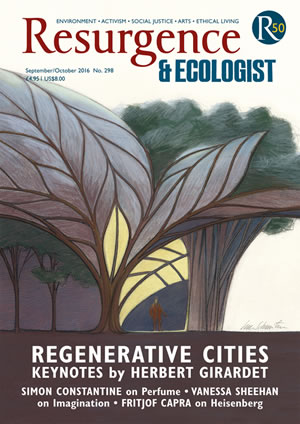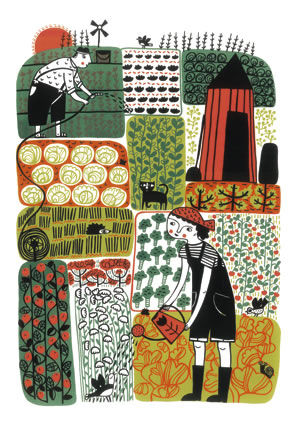I am a great fan of Colin Tudge, not least because he is an original thinker, as amply demonstrated in his latest book, Six Steps Back to the Land. I also have direct experience in relation to his theme, since I literally got “back to the land” in the 1970s. So when the editor of Resurgence & Ecologist asked me to review the book, I decided to compare my experience with Colin’s recommendations.
Before giving some hard advice for would-be sustainable food producers, Colin sets the stage for an agrarian renaissance, setting out the case and the need for fundamental changes to our food and farming systems. I am certain that he is right about the urgent need for a complete transformation of our approach to producing food. I am also of the opinion that the external conditions are better aligned for this change than at any point in my 30 years of engagement with matters of food and farming, largely because of the growth of interest amongst so-called millennials.
Colin then takes us on a journey of the issues facing our food system – why we need change, and how we can achieve it. Beginning with “The road to enlightened agriculture”, he looks at the challenges, including the need for “an economy fit for farming”, ideally a circular economy. He explains the principles of agro-ecology, with an emphasis on small-scale mixed farms. Finally, he explores the ways in which people can get back to the land, all illustrated with excellent case studies.
Our current neoliberal capitalist economic system is far from perfect for sustainable food production, with the economic climate favouring intensive methods and making the back-to-the-land journey unprofitable. Colin is an advocate of reform to put things right, and so am I. The Sustainable Food Trust is working on True Cost Accounting, a project that aims to ensure that food producers who use intensive methods are more accountable economically for the damage they cause to natural capital, the environment and public health, and, conversely, that sustainable producers benefit from the goods and services they deliver.
In chapters 12 and 13 of Six Steps Back to the Land, Colin suggests a pathway for aspirants on the journey. I found it interesting to compare my experiences, starting with finance.
He begins by suggesting that would-be back-to-the-landers will need to rely on gifts from friends and relatives. This is exactly how I got started when we established a rural commune with six others in 1973. One of our couples’ parents purchased the farm, and we set up a company to rent the land and operate the farm.
On the importance of loans, again Colin is right. We secured interest-free, short-term loans from friends and also managed to negotiate limited borrowing from our bank. At that time, no charitable foundation would have considered grant-aiding our initiative, and in any case we would not have been eligible, since we were operating as a business as opposed to a not-for-profit. But after Britain joined the then European common market, we were able to benefit from government grants, as is the case today.
Since it was not possible to present potential investors with a business case proposition guaranteeing a profit, we did not consider this. But many years later I approached Triodos Bank for a mortgage and overdraft to enable me to purchase the farm, and without that support I would not have been able to secure the freehold.
Financing an entry into farming is far from easy; in all probability it will need to involve most or all of the steps that Colin Tudge suggests. In my case, this was followed by 30 years of financial insecurity, shored up by my day job, before I crossed the threshold of freehold farm ownership. But the struggle to gain a foothold in farming might not have been such a bad thing, as I am still not completely convinced that it is ever really possible to ‘own’ land – one is simply a temporary steward.
Turning back to Colin’s six practical steps, how do they align with my own experiences? First, he says: “No one should contemplate a market garden unless they are already good at growing.” I agree. Second, Colin recommends starting with growing vegetables and adding livestock second. My interest was always the other way round, so our main focus was on acquiring a dairy herd, although the idea of being self-sufficient in vegetables did feature in our farm plan.
Third, Colin adds grazing. This is also at odds with my experience, but we were lucky to have access to the resources that would enable the purchase of our 135-acre farm, which provided grazing for our cattle. Renting land is a perfectly good option for an aspirant food producer.
Colin says arable farming comes next, and this aligns with our experience. We started with grass, and then grew wheat, stone-milled on the farm, to supply a local wholefood shop. More recently, we have been growing oats and peas to provide the concentrate fraction of the ration for our dairy cows, with the eventual aim of becoming self-sufficient in animal feed.
Step 5, Colin says, is the full-blown agro-ecological mixed farm. We are still aspiring to reach this pinnacle, but this must be the ultimate aim.
Lastly, Colin’s Step 6 extols farms as communities. I can testify that sharing a house with seven others – including a couple of children – in the end proved unsustainable. Notwithstanding this, I remain wedded to the ideal of future farming systems involving communities of people working together, though I believe it is essential to have a reasonable degree of social and family autonomy.
This certainly isn’t a standard book review, but I hope that it may be of interest, since my experience provides a case study very closely aligned to Colin’s advocacy of the agrarian renaissance route map.
Is he a dreamer? Of course he is! But that is both the charm of the book and the charm of the man.








